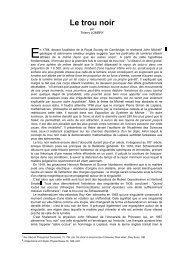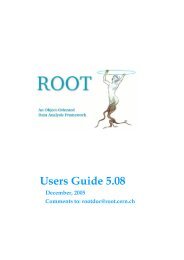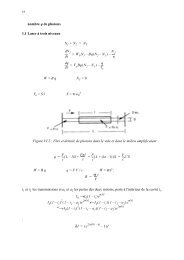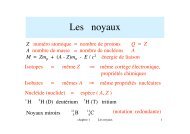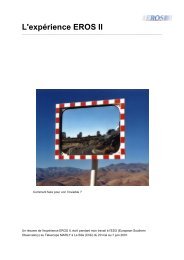Climate change impact: Mapping thermal stress on Carrara marble ...
Climate change impact: Mapping thermal stress on Carrara marble ...
Climate change impact: Mapping thermal stress on Carrara marble ...
You also want an ePaper? Increase the reach of your titles
YUMPU automatically turns print PDFs into web optimized ePapers that Google loves.
Science of the Total Envir<strong>on</strong>ment 407 (2009) 4506–4512<br />
C<strong>on</strong>tents lists available at ScienceDirect<br />
Science of the Total Envir<strong>on</strong>ment<br />
journal homepage: www.elsevier.com/locate/scitotenv<br />
<str<strong>on</strong>g>Climate</str<strong>on</strong>g> <str<strong>on</strong>g>change</str<strong>on</strong>g> <str<strong>on</strong>g>impact</str<strong>on</strong>g>: <str<strong>on</strong>g>Mapping</str<strong>on</strong>g> <str<strong>on</strong>g>thermal</str<strong>on</strong>g> <str<strong>on</strong>g>stress</str<strong>on</strong>g> <strong>on</strong> <strong>Carrara</strong> <strong>marble</strong> in Europe<br />
A. B<strong>on</strong>azza ⁎, C. Sabbi<strong>on</strong>i, P. Messina, C. Guaraldi, P. De Nuntiis<br />
Institute of Atmospheric Sciences and <str<strong>on</strong>g>Climate</str<strong>on</strong>g>, Nati<strong>on</strong>al Research Council, Bologna, Italy<br />
article<br />
info<br />
abstract<br />
Article history:<br />
Received 14 October 2008<br />
Received in revised form 3 April 2009<br />
Accepted 7 April 2009<br />
Available <strong>on</strong>line 8 May 2009<br />
Keywords:<br />
<str<strong>on</strong>g>Climate</str<strong>on</strong>g> <str<strong>on</strong>g>change</str<strong>on</strong>g><br />
Thermal <str<strong>on</strong>g>stress</str<strong>on</strong>g><br />
Marble<br />
Risk<br />
Europe<br />
The <str<strong>on</strong>g>impact</str<strong>on</strong>g> of climate <str<strong>on</strong>g>change</str<strong>on</strong>g> <strong>on</strong> m<strong>on</strong>uments and historic buildings is addressed for the first time, in terms of<br />
modelling and predicting <str<strong>on</strong>g>thermal</str<strong>on</strong>g> <str<strong>on</strong>g>stress</str<strong>on</strong>g> <strong>on</strong> st<strong>on</strong>e in Europe over the next century. While the effect of<br />
changing climate <strong>on</strong> frost in porous materials and <strong>on</strong> surface recessi<strong>on</strong> of carb<strong>on</strong>ate st<strong>on</strong>e, has recently been<br />
treated, predicti<strong>on</strong> of the future evoluti<strong>on</strong> of <str<strong>on</strong>g>thermal</str<strong>on</strong>g> <str<strong>on</strong>g>stress</str<strong>on</strong>g> <strong>on</strong> st<strong>on</strong>es still requires elucidati<strong>on</strong>. The present<br />
paper provides maps showing future scenarios of <str<strong>on</strong>g>thermal</str<strong>on</strong>g> <str<strong>on</strong>g>stress</str<strong>on</strong>g> <strong>on</strong> <strong>Carrara</strong> <strong>marble</strong> for the 21st century, using<br />
the output data from the Hadley general and regi<strong>on</strong>al climate models in the European window.<br />
The work carried out made it possible to forecast in the near and far futures (i.e. 2010–2039, 2070–2099) the<br />
number of events per year of <str<strong>on</strong>g>thermal</str<strong>on</strong>g> <str<strong>on</strong>g>stress</str<strong>on</strong>g> in <strong>marble</strong> greater than 20 MPa, the latter being adopted as the<br />
maximum sustainable load for this specific material. The data dem<strong>on</strong>strate that the Mediterranean area will<br />
c<strong>on</strong>tinue to experience the highest level of risk from <str<strong>on</strong>g>thermal</str<strong>on</strong>g> <str<strong>on</strong>g>stress</str<strong>on</strong>g>, with more than 300 events/year<br />
predicted in the 2070–2099 period. In additi<strong>on</strong>, Central Europe will be more affected by <str<strong>on</strong>g>thermal</str<strong>on</strong>g> <str<strong>on</strong>g>stress</str<strong>on</strong>g> during<br />
the present century compared to the baseline period, 1961–1990, taken as reference.<br />
© 2009 Elsevier B.V. All rights reserved.<br />
1. Introducti<strong>on</strong><br />
Observati<strong>on</strong>s of climate <str<strong>on</strong>g>change</str<strong>on</strong>g> over the past hundred years have<br />
induced the research sector to invest greater resources in forecasting<br />
its future evoluti<strong>on</strong> and ensuing <str<strong>on</strong>g>impact</str<strong>on</strong>g>s. So far, efforts have focused<br />
<strong>on</strong> improving knowledge of future climate effects <strong>on</strong> water resources,<br />
marine systems, agriculture, biodiversity, energy supplies and human<br />
health. Only within the EC Noah's Ark Project (2004–2007, http://<br />
noahsark.isac.cnr.it/), was cultural heritage finally c<strong>on</strong>sidered am<strong>on</strong>g<br />
the sectors threatened by climate <str<strong>on</strong>g>change</str<strong>on</strong>g> (Sabbi<strong>on</strong>i et al., 2007). Apart<br />
from c<strong>on</strong>trasting an intellectual approach that does not attribute<br />
priority status to cultural heritage, the main difficulty linked to such<br />
issues arises from the remaining uncertainty involved in modelling<br />
the damage processes acting <strong>on</strong> materials, both individually and<br />
simultaneously, due to the <str<strong>on</strong>g>impact</str<strong>on</strong>g> of climate parameters.<br />
In that sense Grossi et al. (2007) were pi<strong>on</strong>eers in addressing the<br />
future evoluti<strong>on</strong> of freezing processes <strong>on</strong> porous st<strong>on</strong>es induced by<br />
temperature variati<strong>on</strong>s. Adopting the noti<strong>on</strong> that freezing and<br />
thawing take place below and above 0 °C, the authors evidenced<br />
that freezing in the future will decrease significantly in temperate<br />
Europe, implying a reducti<strong>on</strong> of frost damage <strong>on</strong> the porous st<strong>on</strong>es<br />
typically used in the m<strong>on</strong>uments located in this area.<br />
Moreover, papers predicting carb<strong>on</strong>ate st<strong>on</strong>e surface recessi<strong>on</strong> for<br />
chemical dissoluti<strong>on</strong>, induced by <str<strong>on</strong>g>change</str<strong>on</strong>g>s in precipitati<strong>on</strong> amount and<br />
atmospheric CO 2 c<strong>on</strong>centrati<strong>on</strong>, have recently been submitted to the<br />
⁎ Corresp<strong>on</strong>ding author. Tel.: +39 0516399571; fax: +39 0516399649.<br />
E-mail address: a.b<strong>on</strong>azza@isac.cnr.it (A. B<strong>on</strong>azza).<br />
attenti<strong>on</strong> of the scientific community (B<strong>on</strong>azza et al., 2009; Grossi<br />
et al., 2008). In particular, these works highlighted the increasing<br />
importance that climate parameters will have in the future compared<br />
to air polluti<strong>on</strong>, in the decay and c<strong>on</strong>servati<strong>on</strong> of built heritage.<br />
Predicti<strong>on</strong> of future st<strong>on</strong>e weathering due to heating and cooling<br />
cycles for temperature variati<strong>on</strong>s has still not been faced. The present<br />
paper provides for the first time Europe-wide maps charting the risk<br />
of <strong>Carrara</strong> <strong>marble</strong> towards <str<strong>on</strong>g>thermal</str<strong>on</strong>g> <str<strong>on</strong>g>stress</str<strong>on</strong>g> as a result of climate <str<strong>on</strong>g>change</str<strong>on</strong>g><br />
for three 30-year periods from 1961 to 2099.<br />
1.1. Thermal <str<strong>on</strong>g>stress</str<strong>on</strong>g> <strong>on</strong> st<strong>on</strong>e<br />
Thermoclastism results in granular disaggregati<strong>on</strong> and material<br />
exfoliati<strong>on</strong> due to the differential <str<strong>on</strong>g>thermal</str<strong>on</strong>g> expansi<strong>on</strong> and c<strong>on</strong>tracti<strong>on</strong><br />
of mineral grains and surface–subsurface st<strong>on</strong>e in resp<strong>on</strong>se to shortand<br />
l<strong>on</strong>g-term temperature fluctuati<strong>on</strong>s, caused by the <str<strong>on</strong>g>impact</str<strong>on</strong>g> of solar<br />
radiati<strong>on</strong> <strong>on</strong> materials. Debate still exists c<strong>on</strong>cerning its efficacy,<br />
magnitude and scale of acti<strong>on</strong>, since weathering agents act synergistically,<br />
making it impossible to assess the effect produced by any single<br />
variable (Blackwelder, 1933; Cooke and Warren, 1973; Camuffo, 1998;<br />
Gómez-Heras et al., 2006). Furthermore this damage process depends<br />
<strong>on</strong> the <str<strong>on</strong>g>thermal</str<strong>on</strong>g> c<strong>on</strong>ductivity of materials, which differs in relati<strong>on</strong> to<br />
their mineralogical compositi<strong>on</strong> and texture (Goudie et al., 1992;<br />
McGreevy et al., 2000; Doulos et al., 2004).<br />
In geomorphological terms, rock weathering by <str<strong>on</strong>g>thermal</str<strong>on</strong>g> <str<strong>on</strong>g>stress</str<strong>on</strong>g><br />
has been dealt with in depth for the Antarctic envir<strong>on</strong>ment by<br />
Hall (1997, 1998,1999) and Hall and André (2001, 2003). In additi<strong>on</strong> to<br />
advancing interesting arguments in support of the significant role<br />
that <str<strong>on</strong>g>thermal</str<strong>on</strong>g> <str<strong>on</strong>g>stress</str<strong>on</strong>g> may play in cold and dry regimes, these authors<br />
0048-9697/$ – see fr<strong>on</strong>t matter © 2009 Elsevier B.V. All rights reserved.<br />
doi:10.1016/j.scitotenv.2009.04.008
A. B<strong>on</strong>azza et al. / Science of the Total Envir<strong>on</strong>ment 407 (2009) 4506–4512<br />
4507<br />
highlighted the importance of high frequency measurements of rock<br />
temperature <str<strong>on</strong>g>change</str<strong>on</strong>g>s in order to identify meaningfully the ΔT/t rates<br />
producing damage, ΔT/t≥2 °C min − 1 being said to cause <str<strong>on</strong>g>thermal</str<strong>on</strong>g><br />
<str<strong>on</strong>g>stress</str<strong>on</strong>g> according to Yatsu (1988).<br />
Marble and granite are dem<strong>on</strong>strated to be the st<strong>on</strong>es most<br />
affected by thermoclastism (Gómez-Heras et al., 2006; Malaga-<br />
Starzec et al., 2002; Schouenburg et al., 2003; Siegesmund et al.,<br />
2007, 2008). However, field tests performed by Viles (2005) aimed at<br />
m<strong>on</strong>itoring weathering <strong>on</strong> <strong>marble</strong> and granite blocks in the Central<br />
Namib Desert, found evidence of a greater resistance of granites with<br />
respect to <strong>marble</strong>s under natural c<strong>on</strong>diti<strong>on</strong>s.<br />
The susceptibility of <strong>marble</strong>s derives from the anisotropy in the<br />
<str<strong>on</strong>g>thermal</str<strong>on</strong>g> resp<strong>on</strong>se of calcite, which expands parallel to the c-axis<br />
and c<strong>on</strong>tracts normal to the c-axis. C<strong>on</strong>sequently, the polycrystalline<br />
<str<strong>on</strong>g>thermal</str<strong>on</strong>g> expansi<strong>on</strong> behaviour of <strong>marble</strong>s can vary from almost<br />
isotropic, for a <strong>marble</strong> with weak texture, to str<strong>on</strong>gly anisotropic,<br />
for a <strong>marble</strong> with a str<strong>on</strong>g texture with or without residual strain<br />
(Siegesmund et al., 2000; Weiss et al., 2003). In additi<strong>on</strong> even if in<br />
the case of metamorphic rocks exhaustive explanati<strong>on</strong> <strong>on</strong> residual<br />
locked-in <str<strong>on</strong>g>stress</str<strong>on</strong>g>es (e.g. residual <str<strong>on</strong>g>stress</str<strong>on</strong>g> generated during the st<strong>on</strong>e<br />
geological history) is still lacking, Winkler (1994) had already<br />
highlighted that pre<str<strong>on</strong>g>stress</str<strong>on</strong>g>ed crystalline <strong>marble</strong> tends to expand<br />
more during the first cycle of heating as the locked-in <str<strong>on</strong>g>stress</str<strong>on</strong>g>es are<br />
released.<br />
The size of the st<strong>on</strong>es undergoing <str<strong>on</strong>g>thermal</str<strong>on</strong>g> cycles must also be<br />
c<strong>on</strong>sidered, as in large rock masses, temperature gradients can give<br />
rise to <str<strong>on</strong>g>thermal</str<strong>on</strong>g> <str<strong>on</strong>g>stress</str<strong>on</strong>g>es as a result of temperature not being a linear<br />
functi<strong>on</strong> of size: the value ΔT necessary to induce cracking decreases<br />
as the rock increases in volume. Thus, large rock bodies do not require<br />
a ΔT value as high as that used in laboratory experiments. Moreover,<br />
laboratory samples are generally not c<strong>on</strong>fined, while it is known that<br />
greater damage occurs when a st<strong>on</strong>e block is not free to expand as a<br />
c<strong>on</strong>sequence of <str<strong>on</strong>g>thermal</str<strong>on</strong>g> <str<strong>on</strong>g>stress</str<strong>on</strong>g> (Lazzarini and Tabasso, 1986; Hall,<br />
1999).<br />
In terms of heritage management, even though the efficacy of<br />
<str<strong>on</strong>g>thermal</str<strong>on</strong>g> <str<strong>on</strong>g>stress</str<strong>on</strong>g> acting al<strong>on</strong>e has still to be dem<strong>on</strong>strated in a natural<br />
envir<strong>on</strong>ment, the possible c<strong>on</strong>sequences of <str<strong>on</strong>g>change</str<strong>on</strong>g>s in temperature<br />
distributi<strong>on</strong> within materials <strong>on</strong> other decay mechanisms must also<br />
be taken into account. For example, temperature c<strong>on</strong>trols the<br />
distributi<strong>on</strong> and pressure of salt crystallizati<strong>on</strong> in the st<strong>on</strong>e pores.<br />
Moreover the higher <str<strong>on</strong>g>thermal</str<strong>on</strong>g> expansi<strong>on</strong> of salts in the pores with<br />
respect to the st<strong>on</strong>e may eventually led to microfracture development<br />
(Winkler, 1994). Gómez-Heras (2006) dem<strong>on</strong>strated that in<br />
the case of sodium chloride, radiative heating favours the formati<strong>on</strong><br />
of sub-efflorescences, implying a greater tendency to spalling in<br />
areas of a building exposed to insolati<strong>on</strong>. In additi<strong>on</strong>, he underlined<br />
that in soft freezing envir<strong>on</strong>ments (−10–0 °C) high insolati<strong>on</strong> can<br />
inhibit freeze–thaw weathering <strong>on</strong> porous st<strong>on</strong>es, even when the air<br />
temperature is below 0 °C.<br />
2. Experimental secti<strong>on</strong><br />
2.1. <str<strong>on</strong>g>Climate</str<strong>on</strong>g> <str<strong>on</strong>g>change</str<strong>on</strong>g> model<br />
For future projecti<strong>on</strong>s, the outputs of two widely used models of<br />
the Hadley Centre (UK) —HadCM3 and HadRM3 — were employed:<br />
HadCM3 is a general model with a grid resoluti<strong>on</strong> of 2.5×3.75°<br />
(295×278 km at 45 N latitude), while HadRM3 is a regi<strong>on</strong>al climate<br />
model that encompasses Europe at a higher resoluti<strong>on</strong> (a grid of<br />
equal-area cells, 50×50 km), but spans <strong>on</strong>ly the years from 2070 to<br />
2099 (Gord<strong>on</strong> et al., 2000). The model outputs were based <strong>on</strong> the A2<br />
scenario (Nakicenovic and Swart, 2000).<br />
The selected geographical area centres <strong>on</strong> Europe, covering a<br />
regi<strong>on</strong> of 80°N–25°N latitude and 33.75°W–67.50°E l<strong>on</strong>gitude for the<br />
general model, and 72°N–35°N latitude and 30°W–55°E l<strong>on</strong>gitude for<br />
the regi<strong>on</strong>al <strong>on</strong>e.<br />
The research utilised daily air maximum and minimum temperature<br />
values extracted from HadCM3 and HadRM3 and processed<br />
for use in the estimati<strong>on</strong> of the risk towards <str<strong>on</strong>g>thermal</str<strong>on</strong>g> <str<strong>on</strong>g>stress</str<strong>on</strong>g> in <strong>marble</strong><br />
for three 30-year periods: 1961–1990 (baseline), 2010–2039 (near<br />
future) and 2070–2099 (far future).<br />
2.2. Damage functi<strong>on</strong><br />
A review was made of previously published works <strong>on</strong> the damage<br />
functi<strong>on</strong>s relating temperature to st<strong>on</strong>e damage processes. Although<br />
numerous studies <strong>on</strong> <str<strong>on</strong>g>thermal</str<strong>on</strong>g> <str<strong>on</strong>g>stress</str<strong>on</strong>g> have been performed <strong>on</strong> the basis<br />
of laboratory and field exposure tests (Blackwelder, 1933; Griggs,<br />
1936; McGreevy et al., 2000; Zhu et al., 2003; Gómez-Heras et al.,<br />
2006), the papers proposing its modelling by functi<strong>on</strong>s remain few<br />
(Timoshenko and Goodier 1970; Mutluturk et al., 2004). By c<strong>on</strong>trast<br />
several models exist for freeze–thaw cycles (Walder and Hallet, 1985;<br />
Nels<strong>on</strong> and Outcalt, 1987; Matsuoka, 1990; López and Mes<strong>on</strong>es, 2001;<br />
Mutluturk et al., 2004).<br />
According to Timoshenko and Goodier (1970) and Turcotte and<br />
Schubert (2002), the maximum <str<strong>on</strong>g>thermal</str<strong>on</strong>g> <str<strong>on</strong>g>stress</str<strong>on</strong>g> (σ T [MPa]) for a<br />
uniform elastic medium c<strong>on</strong>fined in the horiz<strong>on</strong>tal directi<strong>on</strong>s and<br />
unc<strong>on</strong>strained in the vertical directi<strong>on</strong> can be calculated by:<br />
σ T = E·α · Δ T = ð1− mÞ ð1Þ<br />
where:<br />
E Young's modulus (GPa)<br />
α Thermal expansi<strong>on</strong> coefficient (K − 1 )<br />
ΔT Actual amplitude of the periodic surface temperature<br />
variati<strong>on</strong><br />
ν Poiss<strong>on</strong>'s ratio<br />
This functi<strong>on</strong>, valid for an isotropic body, has already been used by<br />
Scheffzϋk etal.(2004), who calculated a maximum horiz<strong>on</strong>tal thermoelastic<br />
<str<strong>on</strong>g>stress</str<strong>on</strong>g> of around 42 MPa for a <strong>marble</strong> with α=7×10 −6 K −1 ,<br />
E = 30 GPa and ν = 0.25, subjected to a cooling of 150 K. Lazzarini<br />
and Tabasso (1986) and Dal Prà (1987) previously evidenced that<br />
the risk of damage for a given material is evaluated through the<br />
comparis<strong>on</strong> between the <str<strong>on</strong>g>thermal</str<strong>on</strong>g> <str<strong>on</strong>g>stress</str<strong>on</strong>g> σ T caused and the maximum<br />
sustainable load specific to that material. The maximum sustainable<br />
load is calculated by dividing the material's compressive strength by<br />
its safety coefficient, which depends both <strong>on</strong> the type of material and<br />
its structural role. For c<strong>on</strong>crete a safety coefficient of 3 is generally<br />
assumed, while higher values are adopted for st<strong>on</strong>e (Dal Prà, 1987;<br />
Blanco, 1991).<br />
The comparis<strong>on</strong> of the <str<strong>on</strong>g>thermal</str<strong>on</strong>g> <str<strong>on</strong>g>stress</str<strong>on</strong>g> σ T obtained using Eq. (1)<br />
with the maximum sustainable load allows an estimati<strong>on</strong> of the risk of<br />
damage for a material undergoing a temperature surface variati<strong>on</strong>.<br />
Surface temperatures may be obtained from field measurements<br />
and laboratory simulati<strong>on</strong>s. However, Eq. (1) cannot be used for future<br />
projecti<strong>on</strong>s, because outputs of climate models generally provide<br />
mean m<strong>on</strong>thly/seas<strong>on</strong>al/yearly data of the air temperature. Therefore,<br />
work was also d<strong>on</strong>e to find a correlati<strong>on</strong> between the daily<br />
air temperature variati<strong>on</strong>s extracted from the general and regi<strong>on</strong>al<br />
Hadley climate models and daily surface temperatures, in an attempt<br />
to make Eq. (1) suitable for producing future scenarios of <str<strong>on</strong>g>thermal</str<strong>on</strong>g><br />
<str<strong>on</strong>g>stress</str<strong>on</strong>g>.<br />
2.3. Envir<strong>on</strong>mental m<strong>on</strong>itoring<br />
Experimental results from the envir<strong>on</strong>mental m<strong>on</strong>itoring campaign<br />
at the UNESCO listed Hagar Qim and Mnajdra Temples <strong>on</strong> the<br />
island of Malta from June 2005 to August 2006, carried out by ISAC-<br />
CNR, were processed al<strong>on</strong>g with the few data available from the
4508 A. B<strong>on</strong>azza et al. / Science of the Total Envir<strong>on</strong>ment 407 (2009) 4506–4512<br />
literature, in order to correlate daily ΔT of the air (ΔT air ) and daily ΔT of<br />
the st<strong>on</strong>e surface (ΔT surface ). The megalithic temples are built mainly<br />
in large blocks of globigerina limest<strong>on</strong>e. Research carried out <strong>on</strong><br />
damage affecting Maltese Cultural Heritage indicates that salt crystallizati<strong>on</strong><br />
is the main deteriorati<strong>on</strong> process affecting the c<strong>on</strong>servati<strong>on</strong><br />
of the temples, and that it acts synergistically with <str<strong>on</strong>g>thermal</str<strong>on</strong>g> <str<strong>on</strong>g>stress</str<strong>on</strong>g> and<br />
wind erosi<strong>on</strong> in causing alveolizati<strong>on</strong>, a phenomen<strong>on</strong> leading to a<br />
complete powdering of the material (Vannucci et al., 1994; Cassar and<br />
Vannucci, 2001). While the present paper addresses projecti<strong>on</strong>s of<br />
<str<strong>on</strong>g>thermal</str<strong>on</strong>g> <str<strong>on</strong>g>stress</str<strong>on</strong>g> <strong>on</strong> <strong>Carrara</strong> <strong>marble</strong>, the Malta campaign was taken into<br />
account because it represents a rare case of m<strong>on</strong>itoring assessment<br />
for the purpose of correlating meteorological data with damage processes<br />
at an outdoor heritage site. With particular reference to our<br />
work, it should be underlined that in the literature, data of both air<br />
and st<strong>on</strong>e surface temperatures for l<strong>on</strong>g-term periods (<strong>on</strong>e year) <strong>on</strong> a<br />
large scale (m<strong>on</strong>oliths) are very scarce (Viles, 2005). Additi<strong>on</strong>ally,<br />
little informati<strong>on</strong> is available <strong>on</strong> m<strong>on</strong>itoring campaigns carried out<br />
directly <strong>on</strong> m<strong>on</strong>uments and archaeological sites (Mandrioli et al.,<br />
2006), providing both air temperature measured in their proximity<br />
and temperatures at the material surface. Malta is characterised by a<br />
Mediterranean climate with low precipitati<strong>on</strong> during most of the year<br />
(maximum mean m<strong>on</strong>thly rainfall of about 110 mm from November to<br />
January) and mean m<strong>on</strong>thly temperature ranging from 13 to 28 °C.<br />
Data recorded over the last 20 years show hot and dry summers, with<br />
maximum temperatures as high as 43 °C in July and August, while the<br />
lowest temperature recorded during winter is 3 °C. Throughout the<br />
year the island is exposed to wind influence, with maximum velocity<br />
ranging between 13 and 20 m/s.<br />
During the <strong>on</strong>e-year campaign, the following meteorological<br />
parameters were measured every 15 min by microclimatic stati<strong>on</strong>s<br />
equipped with sensors: air temperature, relative humidity, rainfall,<br />
solar radiati<strong>on</strong> and barometric pressure. Wind speed and directi<strong>on</strong><br />
were measured by two 5 m wind poles installed in proximity of the<br />
temples. The c<strong>on</strong>tinuous m<strong>on</strong>itoring was carried out through a local<br />
wireless network c<strong>on</strong>nected by GSM modem to the Data Management<br />
Centre (DMC) of the ISAC-CNR Institute, Bologna, Italy. All the data<br />
from the remote sites were daily transmitted and uploaded into the<br />
DMC database.<br />
In additi<strong>on</strong>, four seas<strong>on</strong>al campaigns took place to study the st<strong>on</strong>e<br />
surface temperature performing <str<strong>on</strong>g>thermal</str<strong>on</strong>g> infrared measurements<br />
<strong>on</strong> the south and south-east facing surfaces of both temples, using<br />
an infrared <str<strong>on</strong>g>thermal</str<strong>on</strong>g> camera (NEC THERMO TRACER TH5104). The surfaces<br />
were m<strong>on</strong>itored c<strong>on</strong>tinuously for 24 h (<strong>on</strong>e thermography every<br />
30 min) in each seas<strong>on</strong> (Figs. 1 and 2). Nearly all the measurements<br />
Fig. 2. Thermography (02/02/2006,10:00 am) relating to the m<strong>on</strong>ument area in Fig. 1.<br />
were performed in clear sky c<strong>on</strong>diti<strong>on</strong>s, in order to ensure the maximum<br />
effect of solar radiati<strong>on</strong> <strong>on</strong> m<strong>on</strong>ument surfaces. The <str<strong>on</strong>g>thermal</str<strong>on</strong>g><br />
camera measures and images the emitted infrared radiati<strong>on</strong> from the<br />
object investigated, which is a functi<strong>on</strong> of the object's emissivity and<br />
corresp<strong>on</strong>ding surface temperature (following Planck's equati<strong>on</strong>). It<br />
allows the acquisiti<strong>on</strong> of a thermographic image with a matrix of<br />
255×223 pixels and temperature resoluti<strong>on</strong> of 0.1 °C. The database of<br />
air and surface temperatures has been utilised in the present work.<br />
3. Results and discussi<strong>on</strong><br />
3.1. St<strong>on</strong>e surface temperature<br />
In Eq. (1) Young's modulus E, <str<strong>on</strong>g>thermal</str<strong>on</strong>g> expansi<strong>on</strong> coefficient α<br />
and Poiss<strong>on</strong>'s ratio ν have specific values for each material, most of<br />
which can be obtained from data in the literature (Dal Prà, 1987;<br />
Blanco, 1991; Fiori et al., 1998; Nichols<strong>on</strong> and Nichols<strong>on</strong>, 2000).<br />
However, to enable the use of Hadley climate model outputs in producing<br />
future scenarios of <str<strong>on</strong>g>thermal</str<strong>on</strong>g> <str<strong>on</strong>g>stress</str<strong>on</strong>g> <strong>on</strong> <strong>marble</strong> using Eq. (1), a<br />
correlati<strong>on</strong> between air temperature and st<strong>on</strong>e surface temperature<br />
is needed.<br />
Lazzarini and Tabasso (1986) found that <strong>marble</strong> m<strong>on</strong>oliths in the<br />
Mediterranean area can undergo <str<strong>on</strong>g>thermal</str<strong>on</strong>g> cycles of 40–50 °C, causing<br />
deformati<strong>on</strong> of some tenths of a millimetre for each meter of length.<br />
Winkler (1994) stated that the maximum surface temperature can<br />
be almost double the maximum air temperature, while the minimum<br />
values of air and surface temperature are comparable, pointing out<br />
that the surface temperatures of black st<strong>on</strong>es are very much higher<br />
(in desert areas, black basalt and dark sandst<strong>on</strong>e recorded almost<br />
80 °C) than those of white rocks in the same climate c<strong>on</strong>diti<strong>on</strong>s. Viles<br />
(2005) performed c<strong>on</strong>tinuous measurements of surface temperature<br />
<strong>on</strong> <strong>marble</strong> and granite every 3 h, and hourly air temperature readings<br />
Table 1<br />
Maximum and minimum daily air and surface temperatures measured during the<br />
envir<strong>on</strong>mental m<strong>on</strong>itoring at the megalithic temples of Malta.<br />
Site Date T air Max<br />
(°C)<br />
T air Min<br />
(°C)<br />
T surface Max<br />
(°C)<br />
T surface Min<br />
(°C)<br />
ΔT surface −<br />
ΔT air<br />
a<br />
Hagar Qim 29/06/2005 28.2 b 24.3 b 40.4 23.4 13.2<br />
Mnajdra 01/07/2005 32.3 24.7 41.7 25.0 9.1<br />
Mnajdra 27/09/2005 26.3 19.4 35.7 15.6 13.2<br />
Hagar Qim 29/09/2005 26.9 18.5 27.7 15.9 3.5<br />
Hagar Qim 02/02/2006 16.2 9.1 35.1 2.5 25.5<br />
Hagar Qim 03/05/2006 21.4 15.3 42.2 10.5 25.6<br />
Mnajdra 06/05/2006 20.9 13.1 29.3 12.5 9.1<br />
Fig. 1. View of the south-facing m<strong>on</strong>oliths of Hagar Qim Temple, Malta Island.<br />
a<br />
[T surface Max−T surface Min] −[T air Max−T air Min].<br />
b Air temperature data from the m<strong>on</strong>itoring stati<strong>on</strong> close to Hagar Qim Temple, other<br />
data are from ISAC m<strong>on</strong>itoring campaign.
A. B<strong>on</strong>azza et al. / Science of the Total Envir<strong>on</strong>ment 407 (2009) 4506–4512<br />
4509<br />
in February and August for three years at four sites in the Central<br />
Namib Desert, showing that in February the daily ΔT surface of <strong>marble</strong><br />
blocks can be 11–20 °C higher than the daily ΔT air . In August the range<br />
can be between 8 and 19 °C. Maximum st<strong>on</strong>e surface temperatures<br />
were found to exceed maximum air temperatures in February by up<br />
to 18 °C and in August by up to 13 °C. C<strong>on</strong>cerning minimum surface<br />
temperatures in February, rock temperatures were generally the same<br />
as air temperatures, or below them by as much as 1.5–2 °C, whereas in<br />
August, rock surface temperature minima were 1 to 4.5 °C below air<br />
temperature minima.<br />
The data obtained during the envir<strong>on</strong>mental m<strong>on</strong>itoring at Hagar<br />
Qim and Manjdra Temples in Malta are summarized in Table 1.<br />
Fig. 3. a. Estimated <str<strong>on</strong>g>thermal</str<strong>on</strong>g> <str<strong>on</strong>g>stress</str<strong>on</strong>g> risk <strong>on</strong> <strong>Carrara</strong> <strong>marble</strong> for 1961–1990 under the A2 scenario derived from HadCM3 output. b. The period 2070–2099. c. The difference map from<br />
baseline to the far future representing the <str<strong>on</strong>g>change</str<strong>on</strong>g>s in number of events per year of maximum <str<strong>on</strong>g>thermal</str<strong>on</strong>g> <str<strong>on</strong>g>stress</str<strong>on</strong>g> higher than 20 MPa.
4510 A. B<strong>on</strong>azza et al. / Science of the Total Envir<strong>on</strong>ment 407 (2009) 4506–4512<br />
Maximum and minimum daily surface temperatures are reported<br />
with the air temperatures measured <strong>on</strong> the days when the surface<br />
<str<strong>on</strong>g>thermal</str<strong>on</strong>g> m<strong>on</strong>itoring was performed. The maximum and minimum<br />
surface temperatures are the mean values of the temperature maxima<br />
and minima, respectively, given by a horiz<strong>on</strong>tal temperature profile <strong>on</strong><br />
the thermographic image in corresp<strong>on</strong>dence to 1 m above ground<br />
level at both sites.<br />
The results show that the difference between daily ΔT surface and<br />
daily ΔT air ranges from 9 to 26 °C. The lowest value identified, i.e. 3 °C,<br />
can be explained by the partially cloudy c<strong>on</strong>diti<strong>on</strong>s <strong>on</strong> 29 September<br />
2005. The greatest differences (up to 26 °C) between daily ΔT surface<br />
and daily ΔT air were identified in February and May.<br />
It should be emphasised that the surface temperatures in Table 1<br />
are not the absolute maximum and minimum values measured at the<br />
temples. In February 2006, for example, some points at Hagar Qim<br />
experienced a daily ΔT surface equal to 42 °C, while in May 2006 a range<br />
of 38 °C was reached. These values are to be compared with the<br />
corresp<strong>on</strong>ding daily ΔT air equal to 5 °C for both periods, meaning a<br />
difference between daily ΔT surface and daily ΔT air ranging from 33 to<br />
37 °C.<br />
Following the processing of the data from the Malta m<strong>on</strong>itoring,<br />
supported by the scarce data reported in the literature, the setting of<br />
daily ΔT surface =daily ΔT air +20 °C was c<strong>on</strong>sidered reas<strong>on</strong>able for<br />
predicting the maximum daily cycle of surface temperature to be used<br />
in the present research. Therefore, substituting in Eq. (1), the<br />
maximum <str<strong>on</strong>g>thermal</str<strong>on</strong>g> <str<strong>on</strong>g>stress</str<strong>on</strong>g> can be calculated by:<br />
σ T = E·α · ðdaily ΔT air + 20 -CÞ= ð1 − mÞ ð2Þ<br />
Eq. (2) was applied in combinati<strong>on</strong> with the outputs of the general<br />
and regi<strong>on</strong>al Hadley models for future scenario producti<strong>on</strong>.<br />
3.2. <str<strong>on</strong>g>Mapping</str<strong>on</strong>g> <str<strong>on</strong>g>thermal</str<strong>on</strong>g> <str<strong>on</strong>g>stress</str<strong>on</strong>g><br />
Europe-wide maps representing the risk towards thermoclastism<br />
<strong>on</strong> <strong>marble</strong>s for the 21st century were produced utilising Eq. (2),<br />
assuming: E=70 GPa, α=8 10 − 6 K − 1 , ν=0.25 and a compressive<br />
strength of 100 MPa. The adopted values refer to <strong>Carrara</strong> <strong>marble</strong><br />
(Blanco, 1991; Fiori et al., 1998). It has to be underlined that <strong>marble</strong>s<br />
from different geometrical and structural positi<strong>on</strong>s within the<br />
Alpi Apuane metamorphic complex, am<strong>on</strong>g them the variety called<br />
“Cararra <strong>marble</strong>”, present a large variability in microfabric types.<br />
<strong>Carrara</strong> <strong>marble</strong> itself can show a nearly homogeneous fabric, with no<br />
or weak grain-shape, or preferred crystallographic orientati<strong>on</strong>. Within<br />
the present work the annealed microfabric (type-A) distinguished<br />
by Molli et al. (2000) was c<strong>on</strong>sidered. This type of microfabric is<br />
characterized by equant polyg<strong>on</strong>al grains (granoblastic or “foam”<br />
microstructure), with straight to slightly curved grain boundaries that<br />
meet in triple points at angles of nearly 120°. c-Axis orientati<strong>on</strong>s show<br />
a random distributi<strong>on</strong> or a weak preferred crystallographic orientati<strong>on</strong>.<br />
This allowed the use of Eq. (2), which is valid for an isotropic<br />
body. The use of a safety coefficient of 5 was c<strong>on</strong>sidered reas<strong>on</strong>able,<br />
leading to a maximum sustainable load of 20 MPa, which is close to<br />
the maximum compressive load admissible for a <strong>marble</strong> m<strong>on</strong>olith;<br />
thereup<strong>on</strong> the number of events per year of maximum <str<strong>on</strong>g>thermal</str<strong>on</strong>g> <str<strong>on</strong>g>stress</str<strong>on</strong>g><br />
higher than 20 MPa were mapped. With regard to surface temperatures,<br />
as illustrated above, daily ΔT surface was taken to be 20 °C higher<br />
than daily ΔT air , which allowed the utilisati<strong>on</strong> of the daily maximum<br />
and minimum air temperatures provided by the Hadley climate<br />
models, for each HadCM3 and HadRM3 grid point for three 30-year<br />
periods: 1961–1990 (baseline), 2010–2039 (near future) and 2070–<br />
2099 (far future).<br />
The maps relate to <strong>Carrara</strong> <strong>marble</strong> with weak, almost n<strong>on</strong>-existent,<br />
calcite texture and polycrystalline isotropic <str<strong>on</strong>g>thermal</str<strong>on</strong>g> expansi<strong>on</strong><br />
behaviour without residual strain. An ideal situati<strong>on</strong> of dry c<strong>on</strong>diti<strong>on</strong>s,<br />
absence of wind and maximum surface exposure to sunlight (south<br />
facing vertical surfaces in winter clear sky c<strong>on</strong>diti<strong>on</strong>s) is c<strong>on</strong>sidered. It<br />
is also to be underlined that no estimati<strong>on</strong> is d<strong>on</strong>e of the locked-in<br />
<str<strong>on</strong>g>stress</str<strong>on</strong>g>es. Nevertheless, it should be borne in mind that for st<strong>on</strong>e<br />
c<strong>on</strong>structi<strong>on</strong>s, a safety coefficient lower than 5 is never adopted, in<br />
order to take in c<strong>on</strong>siderati<strong>on</strong> possible hidden defects and weakness<br />
(such as locked-in <str<strong>on</strong>g>stress</str<strong>on</strong>g>).<br />
Fig. 3a–b maps the number of events per year of maximum <str<strong>on</strong>g>thermal</str<strong>on</strong>g><br />
<str<strong>on</strong>g>stress</str<strong>on</strong>g> higher than 20 MPa obtained with the general climate model<br />
HadCM3 for the two 30-year periods, from 1961 to 1990 (baseline),<br />
and from 2070 to 2099 (far future), respectively. The maps report<br />
absolute values, distinguishing the geographical areas according to the<br />
different number of events experienced per year. Fig. 3c shows the<br />
difference between the two periods, far future and baseline. It does<br />
not report absolute values, but highlights the <str<strong>on</strong>g>change</str<strong>on</strong>g>s in the number<br />
of events occurring in the far future with respect to the baseline<br />
(period assumed as reference).<br />
Fig. 4 illustrates the number of events for the far future obtained<br />
with the regi<strong>on</strong>al climate model HadRM3, which provides higher<br />
resoluti<strong>on</strong> outputs.<br />
Fig. 4. Estimated <str<strong>on</strong>g>thermal</str<strong>on</strong>g> <str<strong>on</strong>g>stress</str<strong>on</strong>g> risk <strong>on</strong> <strong>Carrara</strong> <strong>marble</strong> for 2070–2099 under the A2 scenario derived from HadRM3 output.
A. B<strong>on</strong>azza et al. / Science of the Total Envir<strong>on</strong>ment 407 (2009) 4506–4512<br />
4511<br />
The results obtained evidence <strong>on</strong> how the Mediterranean Basin<br />
will generally c<strong>on</strong>tinue to experience the highest level of risk, in some<br />
cases with more than 300 events per year, meaning almost <strong>on</strong>e event<br />
per day. In additi<strong>on</strong>, Central Europe and the south of England will be<br />
increasingly affected in the future, while a decreasing risk is predicted<br />
for northern Europe and some areas of the European landmass.<br />
The most marked <str<strong>on</strong>g>change</str<strong>on</strong>g> in <str<strong>on</strong>g>thermal</str<strong>on</strong>g> <str<strong>on</strong>g>stress</str<strong>on</strong>g> risk across the century is<br />
the general increase throughout the Mediterranean Basin and Europe—<br />
particularly Spain, France, Italy, and the Balkan Peninsula–Turkey and<br />
North Africa, with a maximum increase of 50 events per year.<br />
4. C<strong>on</strong>clusi<strong>on</strong>s<br />
The work presented represents the first attempt to predict the risk<br />
of <str<strong>on</strong>g>thermal</str<strong>on</strong>g> <str<strong>on</strong>g>stress</str<strong>on</strong>g> <strong>on</strong> <strong>Carrara</strong> <strong>marble</strong> over the next century, by mapping<br />
the number of events per year with maximum <str<strong>on</strong>g>stress</str<strong>on</strong>g> higher than<br />
20 MPa. It is important to underline that the functi<strong>on</strong> utilised allowed a<br />
good combinati<strong>on</strong> of st<strong>on</strong>e-related variables with the output extracted<br />
from climate models, this being a necessary step towards providing<br />
future projecti<strong>on</strong>s of damage processes. Furthermore the approach<br />
adopted may be extended to mapping the risk <strong>on</strong> other st<strong>on</strong>e typologies,<br />
up<strong>on</strong> proper selecti<strong>on</strong> of Young's modulus and <str<strong>on</strong>g>thermal</str<strong>on</strong>g><br />
expansi<strong>on</strong> coefficient. The determinati<strong>on</strong> of the difference between<br />
daily ΔT surface and daily ΔT air in different envir<strong>on</strong>ments and for different<br />
materials remains an existing gap in knowledge that needs to be<br />
filled through specific m<strong>on</strong>itoring campaigns. Moreover, it has to be<br />
underlined that <str<strong>on</strong>g>change</str<strong>on</strong>g>s in microclimate c<strong>on</strong>diti<strong>on</strong>s, c<strong>on</strong>diti<strong>on</strong>ed by<br />
factors such as aspect, shading, wetting, and st<strong>on</strong>e <str<strong>on</strong>g>thermal</str<strong>on</strong>g> properties,<br />
can influence <str<strong>on</strong>g>thermal</str<strong>on</strong>g> <str<strong>on</strong>g>stress</str<strong>on</strong>g>es. Thus, further research is undoubtedly<br />
required in order to account for the effects of cloud shading and wind in<br />
the heating/cooling cycles <strong>on</strong> st<strong>on</strong>e surfaces. Additi<strong>on</strong>ally, in dealing<br />
with m<strong>on</strong>uments, a comprehensive spatial understanding of sunlight<br />
exposure <strong>on</strong> architectural elements is necessary. Another effect to be<br />
c<strong>on</strong>sidered is the <str<strong>on</strong>g>thermal</str<strong>on</strong>g> shock occurring when a heated surface is<br />
wetted or affected by sudden rainfall.<br />
Work should proceed in two main directi<strong>on</strong>s: the development of<br />
more realistic damage functi<strong>on</strong>s, including the critical climate<br />
parameters (intensity and declinati<strong>on</strong> of solar radiati<strong>on</strong> in this specific<br />
case), and the improvement of the spatial and temporal resoluti<strong>on</strong><br />
of existing climate models for future projecti<strong>on</strong>s. The last point is of<br />
fundamental importance, the downscaling of climate models being<br />
necessary for an understanding of climate <str<strong>on</strong>g>change</str<strong>on</strong>g> <str<strong>on</strong>g>impact</str<strong>on</strong>g> <strong>on</strong> cultural<br />
heritage assets. For such purposes, envir<strong>on</strong>mental m<strong>on</strong>itoring campaigns<br />
carried out in proximity of m<strong>on</strong>uments and archaeological<br />
remains, are fundamental prerequisites for the determinati<strong>on</strong> of<br />
strategies of preventive c<strong>on</strong>servati<strong>on</strong>.<br />
In terms of heritage management, the maps presented indicate<br />
that m<strong>on</strong>uments built in <strong>marble</strong> will undergo an increasing risk of<br />
<str<strong>on</strong>g>thermal</str<strong>on</strong>g> <str<strong>on</strong>g>stress</str<strong>on</strong>g> in the future, especially in those areas in which their<br />
density (number of m<strong>on</strong>uments/area) is highest, such as Italy, Greece,<br />
Turkey.<br />
For preventive management, it is urgent to c<strong>on</strong>sider the <str<strong>on</strong>g>impact</str<strong>on</strong>g> of<br />
climate <str<strong>on</strong>g>change</str<strong>on</strong>g> <strong>on</strong> cultural heritage <strong>on</strong> the basis of the existing<br />
knowledge <strong>on</strong> both material damage and climate predicti<strong>on</strong>s.<br />
Scientifically valid mitigati<strong>on</strong> and adaptati<strong>on</strong> strategies may <strong>on</strong>ly be<br />
developed if the scientific community directs its research results<br />
within the future perspective.<br />
Acknowledgments<br />
This work forms part of the EC Project “Global climate <str<strong>on</strong>g>change</str<strong>on</strong>g><br />
<str<strong>on</strong>g>impact</str<strong>on</strong>g> <strong>on</strong> built heritage and cultural landscapes — NOAH'S ARK”,<br />
supported by the European Commissi<strong>on</strong>, within the 6th Framework<br />
Program <strong>on</strong> research (C<strong>on</strong>tract nr. SSPI-CT-2003-501837-NOAH'S<br />
ARK). It also benefits from the project “Envir<strong>on</strong>mental M<strong>on</strong>itoring at<br />
Hagar Qim and Manjdra Temples”, funded by Heritage Malta.<br />
The authors gratefully acknowledge Dr. Paolo Mandrioli, Prof.<br />
Giacomo Moric<strong>on</strong>i and Prof. Giovanni Santarato for the stimulating<br />
and fruitful discussi<strong>on</strong>s.<br />
References<br />
Blackwelder E. The insolati<strong>on</strong> hypothesis of rock weathering. Am J Sci 1933;26<br />
(152):97-113 (5th Series).<br />
Blanco G. Pavimenti e Rivestimenti Lapidei (Selezi<strong>on</strong>e, posa in opera e restauro delle<br />
pietre ornamentali). Roma: NIS — La Nuova Italia Scientifica; 1991 (Manuali del<br />
progettista / 22).<br />
B<strong>on</strong>azza A, Messina P, Sabbi<strong>on</strong>i C, Grossi CM, Brimblecombe P. <str<strong>on</strong>g>Mapping</str<strong>on</strong>g> the <str<strong>on</strong>g>impact</str<strong>on</strong>g> of<br />
climate <str<strong>on</strong>g>change</str<strong>on</strong>g> <strong>on</strong> surface recessi<strong>on</strong> of carb<strong>on</strong>ate buildings in Europe. Sci Total<br />
Envir<strong>on</strong> 2009;407:2039–50.<br />
Camuffo D. Microclimate for cultural heritage. Developments in Atmospheric Science,<br />
vol. 23. Amsterdam: Elsevier; 1998. 415 pp.<br />
Cassar J, Vannucci S. Petrographical and chemical research <strong>on</strong> the st<strong>on</strong>e of the<br />
megalithic temples. Malta Archaeol Rev 2001;5:40–5.<br />
Cooke RU, Warren A. Geomorphology in Deserts, vol. iii–xii, 394. L<strong>on</strong>d<strong>on</strong>: Batsford; 1973.<br />
Dal Prà A. Lezi<strong>on</strong>i di Geologia Applicata ai Materiali Naturali da Costruzi<strong>on</strong>e; 1987.<br />
Padova, 103 pp.<br />
Doulos L, Santamouris M, Livada I. Passive cooling of outdoor urban spaces. The role of<br />
materials. Solar Energy 2004;77:231–49.<br />
Fiori C, Barb<strong>on</strong>i R, Sarag<strong>on</strong>i L. Marmi ed altre pietre nel mosaico antico e moderno.<br />
Artestampa, Ravenna: Quaderni IRTEC; 1998. 303 pp.<br />
Gómez-Heras M. Procesos y formas de deterioro térmico en piedra natural del<br />
patrim<strong>on</strong>io architectónico. Madrid: Editorial Complutense; 2006. 339 pp.<br />
Gómez-Heras M, Smith BJ, Fort R. Surface temperature differences between minerals in<br />
crystalline rocks: implicati<strong>on</strong>s for granular disaggregati<strong>on</strong> of granites for <str<strong>on</strong>g>thermal</str<strong>on</strong>g><br />
fatigue. Geomorphology 2006;78:236–49.<br />
Gord<strong>on</strong> C, Cooper C, Senior CA, Banks HT, Gregory JM, Johns TC, et al. The simulati<strong>on</strong> of<br />
SST, sea ice extents and ocean heat transports in a versi<strong>on</strong> of the Hadley Centre<br />
coupled model without flux adjustments. Clim Dyn 2000;16:147–68.<br />
Goudie AS, Allis<strong>on</strong> RJ, McLaren SJ. The relati<strong>on</strong>s between modulus of elasticity and<br />
temperature in the c<strong>on</strong>text of the experimental simulati<strong>on</strong> of rock weathering by<br />
fire. Earth Surf Processes Landf 1992;17:605–15.<br />
Griggs DT. The factor of fatigue in rock exfoliati<strong>on</strong>. J Geol 1936;44:783–96.<br />
Grossi CM, Brimblecombe P, Harris I. Predicting l<strong>on</strong>g-term freeze–thaw risks <strong>on</strong><br />
Europe built heritage and archaeological sites in a changing climate. Sci Total<br />
Envir<strong>on</strong> 2007;377:273–81.<br />
Grossi CM, B<strong>on</strong>azza A, Brimblecombe P, Harris I, Sabbi<strong>on</strong>i C. Predicting twenty-first century<br />
recessi<strong>on</strong> of architectural limest<strong>on</strong>e in European cities. Envir<strong>on</strong> Geol 2008;56(3–4):<br />
455–61. http://www.springerlink.com/c<strong>on</strong>tent/u329j7j7k61u251h/fulltext.pdf.<br />
Hall K. Rock temperatures and implicati<strong>on</strong>s for cold regi<strong>on</strong> weathering: I. New<br />
data from Viking Valley, Alexander Island (Antarctica). Permafr Periglac Process<br />
1997;8:69–90.<br />
Hall K. Rock temperatures and implicati<strong>on</strong>s for cold regi<strong>on</strong> weathering: II. New data<br />
from Rothera, Adelaide Island (Antarctica). Permafr Periglac Process 1998;9:47–55.<br />
Hall K. The role of <str<strong>on</strong>g>thermal</str<strong>on</strong>g> <str<strong>on</strong>g>stress</str<strong>on</strong>g> fatigue in the breakdown of rock in cold regi<strong>on</strong>s.<br />
Geomorphology 1999;31:47–63.<br />
Hall K, André MF. New insights into rock weathering from high-frequency rock<br />
temperature data: and Antarctic study of weathering by <str<strong>on</strong>g>thermal</str<strong>on</strong>g> <str<strong>on</strong>g>stress</str<strong>on</strong>g>.<br />
Geomorphology 2001;41(1):23–35.<br />
Hall K, André MF. Rock <str<strong>on</strong>g>thermal</str<strong>on</strong>g> data at the grain scale: applicability to granular<br />
disintegrati<strong>on</strong> in cold envir<strong>on</strong>ments. Earth Surf Processes Landf 2003;28:823–36.<br />
Hallet B. The breakdown of rock due to freezing: a theoretical model. Proc. 4th<br />
Internati<strong>on</strong>al C<strong>on</strong>ference <strong>on</strong> Permafrost, Fairbanks, Alaska. Washingt<strong>on</strong>: Nati<strong>on</strong>al<br />
Academy Press; 1983. p. 433–8.<br />
Lazzarini L, Tabasso ML. Il restauro della pietra. Padova: CEDAM; 1986. xx pp.<br />
López G, Mes<strong>on</strong>es F. Manual para el uso de la piedra en la arquitectura. Bilbao: ITB; 2001.<br />
Malaga-Starzec K, Lindqvist JE, Schouenburg B. Experimental study <strong>on</strong> the variati<strong>on</strong> in<br />
porosity of <strong>marble</strong> as a functi<strong>on</strong> of temperature. In: Siegesmund S, Weiss T,<br />
Vollbrecht A, editors. Natural St<strong>on</strong>e, Weathering Phenomena, C<strong>on</strong>servati<strong>on</strong><br />
Strategies and Case Studies, vol. 205. L<strong>on</strong>d<strong>on</strong>: Geological Society; 2002. p. 81–8.<br />
Mandrioli P, De Nuntiis P, Guaraldi C, M<strong>on</strong>co A, Sabbi<strong>on</strong>i C, B<strong>on</strong>azza A, et al. Envir<strong>on</strong>mental<br />
m<strong>on</strong>itoring at Hagar Qim and Mnajdra Temples. Final Report Tender CT 2592/04;<br />
2006.<br />
Matsuoka N. The rate of bedrock weathering by frost acti<strong>on</strong>: field measurements and a<br />
predictive model. Earth Surf Processes Landf 1990;15:73–90.<br />
McGreevy JP, Warke PA, Smith BJ. C<strong>on</strong>trols <strong>on</strong> st<strong>on</strong>e temperatures and the benefits of<br />
interdisciplinary ex<str<strong>on</strong>g>change</str<strong>on</strong>g>. J Am Inst C<strong>on</strong>serv 2000;39(2):259–74.<br />
Molli G, C<strong>on</strong>ti P, Giorgetti G, Meccheri M, Oesterling N. Microfabric study <strong>on</strong> the<br />
deformati<strong>on</strong>al and <str<strong>on</strong>g>thermal</str<strong>on</strong>g> history of the Alpi Apuane <strong>marble</strong>s (<strong>Carrara</strong> <strong>marble</strong>s),<br />
Italy. J Struct Geol 2000;22:1809–25.<br />
Mutluturk M, Altindag R, Turk G. A decay functi<strong>on</strong> model for the integrity loss of rock<br />
when subjected to recurrent cycles of freezing–thawing and heating–cooling. Int J<br />
Rock Mech Min Sci 2004;41:237–44.<br />
Nakicenovic N, Swart R. Emissi<strong>on</strong>s Scenarios: A Special Report of Working Group III of<br />
the Intergovernmental Panel <strong>on</strong> <str<strong>on</strong>g>Climate</str<strong>on</strong>g> Change. Cambridge: Cambridge University<br />
Press; 2000.<br />
Nels<strong>on</strong> FE, Outcalt SI. A computati<strong>on</strong>al method for predicti<strong>on</strong> and regi<strong>on</strong>alizati<strong>on</strong> of<br />
permafrost. Art Alp Res 1987;19(3):279–88.<br />
Nichols<strong>on</strong> DT, Nichols<strong>on</strong> FH. Physical deteriorati<strong>on</strong> of sedimentary rocks subjected to<br />
experimental freeze–thaw weathering. Earth Surf Processes Landf 2000;25:1295–307.
4512 A. B<strong>on</strong>azza et al. / Science of the Total Envir<strong>on</strong>ment 407 (2009) 4506–4512<br />
Sabbi<strong>on</strong>i C, Brimblecombe P, B<strong>on</strong>azza A, Grossi CM, Harris I, Messina P. <str<strong>on</strong>g>Mapping</str<strong>on</strong>g> <str<strong>on</strong>g>Climate</str<strong>on</strong>g><br />
Change and Cultural Heritage. In: Drdácký M, editor. Proc. 7th EC Prague C<strong>on</strong>ference<br />
<strong>on</strong> Safeguarded Cultural Heritage — Understanding & Viability for the Enlarged<br />
Europe, Prague, Czech Republic. 31 May–3 June 2006. ITAM CAS; 2007. p. 119–24.<br />
Scheffzϋk C, Siegesmund S, Koch A. Strain investigati<strong>on</strong>s <strong>on</strong> calcite <strong>marble</strong>s using<br />
neutr<strong>on</strong> time-of-flight diffracti<strong>on</strong>. Envir<strong>on</strong> Geol 2004;46:468–76.<br />
Schouenburg B, Grelk B, Brundin JA, Blasi P, Yates T, Marini P, et al. TEAM — Testing and<br />
assessment of <strong>marble</strong> and limest<strong>on</strong>e cladding. Paper presented at the Symposium<br />
<strong>on</strong> Industrial Minerals and Building St<strong>on</strong>es IMBS; Instabul, Turkey; 2003.<br />
Siegesmund S, Ullmeyer K, Weiss T, Tschegg EK. Physical weathering of <strong>marble</strong>s caused<br />
by anisotropic <str<strong>on</strong>g>thermal</str<strong>on</strong>g> expansi<strong>on</strong>. Int J Earth Sci 2000;89:170–82.<br />
Siegesmund S, Mosch S, Scheffzϋk Ch, Nikolayev DI. The bowing potential of granitic<br />
rocks: rock fabrics, <str<strong>on</strong>g>thermal</str<strong>on</strong>g> properties and residual strain. Envir<strong>on</strong> Geol 2007;55(7):<br />
1437–48. http://www.springerlink.com/c<strong>on</strong>tent/e670423g702x8117/fulltext.pdf.<br />
Siegesmund S, Ruedrich J, Koch A. Marble bowing: comparative studies of three different<br />
public building facades. Envir<strong>on</strong> Geol 2008;56(3–4):473–94. http://www.<br />
springerlink.com/c<strong>on</strong>tent/k0q7518wt3885n36/fulltext.pdf.<br />
Timoshenko SP, Goodier JN. Theory of elasticity. 3rd edn. New York: McGraw-Hill; 1970.<br />
Turcotte DL, Schubert G. Geodynamics. 2nd edn. Cambridge: University Press; 2002.<br />
Vannucci S, Alessandrini G, Cassar J, Tamp<strong>on</strong>e G, Vannucci ML. I templi megalitici<br />
preistorici delle isole maltesi: cause e processi di degradazi<strong>on</strong>e del Globigerina<br />
limest<strong>on</strong>e. C<strong>on</strong>servati<strong>on</strong> of M<strong>on</strong>uments in the Mediterranean Basin, Proceedings of<br />
the 3rd Internati<strong>on</strong>al Symposium, Venice, Italy; 1994. p. 555–65.<br />
Viles HA. Microclimate and weathering in the central Namib Desert, Namibia. Geomorphology<br />
2005;67:189–209.<br />
Walder J, Hallet B. A theoretical model of the fracture of rock during freezing. Geol Soc<br />
Am Bull 1985;96:336–46.<br />
Weiss T, Siegesmund S, Fuller ER. Thermal degradati<strong>on</strong> of <strong>marble</strong>: indicati<strong>on</strong>s from<br />
finite-element modelling. Build Envir<strong>on</strong> 2003;38:1251–60.<br />
Winkler EM. St<strong>on</strong>e in architecture. 3rd edn. New York: Springer; 1994. 313 pp.<br />
Yatsu E. The nature of weathering. Tokyo: Sozosha; 1988.<br />
Zhu I, Wang J, Bing-yuan I. The <str<strong>on</strong>g>impact</str<strong>on</strong>g> of solar radiati<strong>on</strong> up<strong>on</strong> rock weathering at low<br />
temperature: a laboratory study. Permafr Periglac Process 2003;14:61–7.



